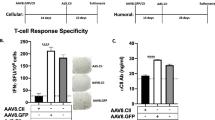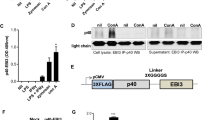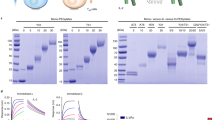Abstract
The application of disease-regulated promoters in local gene therapy for rheumatoid arthritis potentiates the development of a sophisticated treatment that relies on a restricted and fine-tuned supply of biologicals. Although several studies have investigated regulated promoters for achieving effective transgene expression during arthritis, none have explored their potential for minimizing deleterious effects arising from constitutive overexpression of transgenes under naive conditions. Using naive and collagen-induced arthritic mice, we examined the applicability of a hybrid interleukin-1 enhancer/interleukin-6 proximal promoter for achieving efficacious murine interleukin-4 gene therapy under arthritic conditions, while minimizing interleukin-4-induced inflammation under naive conditions. We found strong upregulation of transgene expression in virally transduced knee joints under arthritic conditions compared to levels in naive animals. Besides its responsiveness, the promoter strength proved sufficient for generating therapeutically efficacious levels interleukin-4, as demonstrated by the successful protection against cartilage erosion in collagen-induced arthritis. Most importantly, promoter-mediated restriction of the potent chemotactic interleukin-4 in naive animals strongly reduced the amounts of inflammatory cell influx. This study suggests the suitability of the interleukin-1 enhancer/interleukin-6 proximal promoter for the development of a local gene therapy strategy for rheumatoid arthritis that requires fine-tuned and restricted expression of transgenes with a pleiotrophic nature.
This is a preview of subscription content, access via your institution
Access options
Subscribe to this journal
Receive 12 print issues and online access
$259.00 per year
only $21.58 per issue
Buy this article
- Purchase on Springer Link
- Instant access to full article PDF
Prices may be subject to local taxes which are calculated during checkout




Similar content being viewed by others
References
Goldring SR . Pathogenesis of bone and cartilage destruction in rheumatoid arthritis. Rheumatology (Oxford) 2003; 42 (Suppl 2): ii11–ii16.
McGonagle D, Conaghan PG, O'Connor P, Gibbon W, Green M, Wakefield R et al. The relationship between synovitis and bone changes in early-untreated rheumatoid arthritis: a controlled magnetic resonance imaging study. Arthritis Rheum 1999; 42: 1706–1711.
Pinals RS, Masi AT, Larsen RA . Preliminary criteria for clinical remission in rheumatoid arthritis. Arthritis Rheum 1981; 24: 1308–1315.
van den Berg WB . Lessons from animal models of arthritis. Curr Rheumatol Rep 2002; 4: 232–239.
Brennan FM, Chantry D, Jackson A, Maini R, Feldmann M . Inhibitory effect of TNF alpha antibodies on synovial cell interleukin-1 production in rheumatoid arthritis. Lancet 198929; 2: 244–247.
Criscione LG, St Clair EW . Tumor necrosis factor-alpha antagonists for the treatment of rheumatic diseases. Curr Opin Rheumatol 2002; 14: 204–211.
Gomez-Reino JJ, Carmona L, Valverde VR, Mola EM, Montero MD . Treatment of rheumatoid arthritis with tumor necrosis factor inhibitors may predispose to significant increase in tuberculosis risk: a multicenter active-surveillance report. Arthritis Rheum 2003; 48: 2122–2127.
Gouze E, Pawliuk R, Pilapil C, Gouze JN, Fleet C, Palmer GD et al. In vivo gene delivery to synovium by lentiviral vectors. Mol Ther 2002; 5: 397–404.
Watanabe S, Imagawa T, Boivin GP, Gao G, Wilson JM, Hirsch R . Adeno-associated virus mediates long-term gene transfer and delivery of chondroprotective IL-4 to murine synovium. Mol Ther 2000; 2: 147–152.
Gouze E, Gouze JN, Palmer GD, Pilapil C, Evans CH, Ghivizzani SC . Transgene persistence and cell turnover in the diarthrodial joint: implications for gene therapy of chronic joint diseases. Mol Ther 2007; 15: 1114–1120.
van de Loo FAJ, van den Berg WB . Gene therapy for rheumatoid arthritis. Lessons from animal models, including studies on interleukin-4, interleukin-10, and interleukin-1 receptor antagonist as potential disease modulators. Rheum Dis Clin North Am 2002; 28: 127–149.
Adriaansen J, Khoury M, de Cortie CJ, Fallaux FJ, Bigey P, Scherman D et al. Reduction of arthritis following intra-articular administration of an adeno-associated virus serotype 5 expressing a disease-inducible TNF-blocking agent. Ann Rheum Dis 2007; 66: 1143–1150.
van de Loo FAJ, de Hooge AS, Smeets RL, Bakker AC, Bennink MB, Arntz OJ et al. An inflammation-inducible adenoviral expression system for local treatment of the arthritic joint. Gene Therapy 2004; 11: 581–590.
van de Loo FAJ . Inflammation-responsive promoters for fine-tuned gene therapy in rheumatoid arthritis. Curr Opin Mol Ther 2004; 6: 537–545.
van de Loo FAJ, Geurts J, van den Berg WB . Gene therapy works in animal models of rheumatoid arthritis…so what!. Curr Rheumatol Rep 2006; 8: 386–393.
Boyle DL, Nguyen KH, Zhuang S, Shi Y, McCormack JE, Chada S et al. Intra-articular IL-4 gene therapy in arthritis: anti-inflammatory effect and enhanced TH2 activity. Gene Therapy 1999; 6: 1911–1918.
Kim SH, Evans CH, Kim S, Oligino T, Ghivizzani SC, Robbins PD . Gene therapy for established murine collagen-induced arthritis by local and systemic adenovirus-mediated delivery of interleukin-4. Arthritis Res 2000; 2: 293–302.
Lubberts E, Joosten LAB, van den Bersselaar L, Helsen MM, Bakker AC, van Meurs JB et al. Adenoviral vector-mediated overexpression of IL-4 in the knee joint of mice with collagen-induced arthritis prevents cartilage destruction. J Immunol 1999; 163: 4546–4556.
Lubberts E, Joosten LAB, Chabaud M, van den Bersselaar L, Oppers B, Coenen-de Roo CJ et al. IL-4 gene therapy for collagen arthritis suppresses synovial IL-17 and osteoprotegerin ligand and prevents bone erosion. J Clin Invest 2000; 105: 1697–1710.
Chomarat P, Banchereau J . An update on interleukin-4 and its receptor. Eur Cytokine Netw 1997; 8: 333–344.
Hiester AA, Metcalf DR, Campbell PA . Interleukin-4 is chemotactic for mouse macrophages. Cell Immunol 1992; 139: 72–80.
Bakker AC, van de Loo FAJ, Joosten LAB, Bennink MB, Arntz OJ, Dmitriev IP et al. A tropism-modified adenoviral vector increased the effectiveness of gene therapy for arthritis. Gene Therapy 2001; 8: 1785–1793.
Bouchelouche K, Andresen L, Alvarez S, Nordling J, Nielsen OH, Bouchelouche P . Interleukin-4 and 13 induce the expression and release of monocyte chemoattractant protein 1, interleukin-6 and stem cell factor from human detrusor smooth muscle cells: synergy with interleukin-1beta and tumor necrosis factor-alpha. J Urol 2006; 175: 760–765.
Feghali CA, Bost KL, Boulware DW, Levy LS . Human recombinant interleukin-4 induces proliferation and interleukin-6 production by cultured human skin fibroblasts. Clin Immunol Immunopathol 1992; 63: 182–187.
Tushinski RJ, Larsen A, Park LS, Spoor E, Williams DE, Mochizuki DY . Interleukin 4 alone or in combination with interleukin 1 stimulates 3T3 fibroblasts to produce colony-stimulating factors. Exp Hematol 1991; 19: 238–244.
Borghaei RC, Rawlings Jr PL, Mochan E . Interleukin-4 suppression of interleukin-1-induced transcription of collagenase (MMP-1) and stromelysin 1 (MMP-3) in human synovial fibroblasts. Arthritis Rheum 1998; 41: 1398–1406.
Jenkins K, Javadi M, Borghaei RC . Interleukin-4 suppresses IL-1-induced expression of matrix metalloproteinase-3 in human gingival fibroblasts. J Periodontol 2004; 75: 283–291.
Bakker AC, van de Loo FAJ, Joosten LAB, Arntz OJ, Varley AW, Munford RS et al. C3-Tat/HIV-regulated intraarticular human interleukin-1 receptor antagonist gene therapy results in efficient inhibition of collagen-induced arthritis superior to cytomegalovirus-regulated expression of the same transgene. Arthritis Rheum 2002; 46: 1661–1670.
Miagkov AV, Varley AW, Munford RS, Makarov SS . Endogenous regulation of a therapeutic transgene restores homeostasis in arthritic joints. J Clin Invest 2002; 109: 1223–1229.
Rygg M, Uhlar CM, Thorn C, Jensen LE, Gaughan DJ, Varley AW et al. In vitro evaluation of an enhanced human serum amyloid A (SAA2) promoter-regulated soluble TNF receptor fusion protein for anti-inflammatory gene therapy. Scand J Immunol 2001; 53: 588–595.
Zhang N, Ahsan MH, Purchio AF, West DB . Serum amyloid A-luciferase transgenic mice: response to sepsis, acute arthritis, and contact hypersensitivity and the effects of proteasome inhibition. J Immunol 2005; 174: 8125–8134.
Varley AW, Coulthard MG, Meidell RS, Gerard RD, Munford RS . Inflammation-induced recombinant protein expression in vivo using promoters from acute-phase protein genes. Proc Natl Acad Sci USA 1995; 92: 5346–5350.
Varley AW, Geiszler SM, Gaynor RB, Munford RS . A two-component expression system that responds to inflammatory stimuli in vivo. Nat Biotechnol 1997; 15: 1002–1006.
Zhang N, Weber A, Li B, Lyons R, Contag PR, Purchio AF et al. An inducible nitric oxide synthase-luciferase reporter system for in vivo testing of anti-inflammatory compounds in transgenic mice. J Immunol 2003; 170: 6307–6319.
de la Fuente C, Santiago F, Deng L, Eadie C, Zilberman I, Kehn K et al. Gene expression profile of HIV-1 Tat expressing cells: a close interplay between proliferative and differentiation signals. BMC Biochem 2002; 3: 14.
de Hooge AS, van de Loo FAJ, Arntz OJ, van den Berg WB . Involvement of IL-6, apart from its role in immunity, in mediating a chronic response during experimental arthritis. Am J Pathol 2000; 157: 2081–2091.
van de Loo FAJ, Arntz OJ, Otterness IG, van den Berg WB . Protection against cartilage proteoglycan synthesis inhibition by antiinterleukin 1 antibodies in experimental arthritis. J Rheumatol 1992; 19: 348–356.
O'Hara R, Murphy EP, Whitehead AS, FitzGerald O, Bresnihan B . Acute-phase serum amyloid a production by rheumatoid arthritis synovial tissue. Arthritis Res 2000; 2: 142–144.
Guc D, Gulati P, Lemercier C, Lappin D, Birnie GD, Whaley K . Expression of the components and regulatory proteins of the alternative complement pathway and the membrane attack complex in normal and diseased synovium. Rheumatol Int 1993; 13: 139–146.
Benito MJ, Murphy E, Murphy EP, van den Berg WB, FitzGerald O, Bresnihan B . Increased synovial tissue NF-kappa B1 expression at sites adjacent to the cartilage-pannus junction in rheumatoid arthritis. Arthritis Rheum 2004; 50: 1781–1787.
Brooks AR, Harkins RN, Wang P, Qian HS, Liu P, Rubanyi GM . Transcriptional silencing is associated with extensive methylation of the CMV promoter following adenoviral gene delivery to muscle. J Gene Med 2004; 6: 395–404.
Mutskov V, Felsenfeld G . Silencing of transgene transcription precedes methylation of promoter DNA and histone H3 lysine 9. EMBO J 2004; 23: 138–149.
Sung RS, Qin L, Bromberg JS . TNF-alpha and IFN-gamma induced by innate anti-adenoviral immune responses inhibit adenovirus-mediated transgene expression. Mol Ther 2001; 3 (Part 1): 757–767.
Elkon KB, Liu CC, Gall JG, Trevejo J, Marino MW, Abrahamsen KA et al. Tumor necrosis factor alpha plays a central role in immune-mediated clearance of adenoviral vectors. Proc Natl Acad Sci USA 1997; 94: 9814–9819.
Zhang HG, Zhou T, Yang P, Edwards III CK, Curiel DT, Mountz JD . Inhibition of tumor necrosis factor alpha decreases inflammation and prolongs adenovirus gene expression in lung and liver. Hum Gene Ther 1998; 9: 1875–1884.
Kozak M . Point mutations define a sequence flanking the AUG initiator codon that modulates translation by eukaryotic ribosomes. Cell 1986; 44: 283–292.
Schiedner G, Hertel S, Kochanek S . Efficient transformation of primary human amniocytes by E1 functions of Ad5: generation of new cell lines for adenoviral vector production. Hum Gene Ther 2000; 11: 2105–2116.
Joosten LAB, Koenders MI, Smeets RL, Heuvelmans-Jacobs M, Helsen MM, Takeda K et al. Toll-like receptor 2 pathway drives streptococcal cell wall-induced joint inflammation: critical role of myeloid differentiation factor 88. J Immunol 2003; 171: 6145–6153.
Joosten LAB, Helsen MM, Saxne T, van de Loo FAJ, Heinegard D, van den Berg WB . IL-1 alpha beta blockade prevents cartilage and bone destruction in murine type II collagen-induced arthritis, whereas TNF-alpha blockade only ameliorates joint inflammation. J Immunol 1999; 163: 5049–5055.
Koenders MI, Lubberts E, Oppers-Walgreen B, van Den BL, Helsen MM, Di Padova FE et al. Blocking of interleukin-17 during reactivation of experimental arthritis prevents joint inflammation and bone erosion by decreasing RANKL and interleukin-1. Am J Pathol 2005; 167: 141–149.
Acknowledgements
This study is financially supported by VIDI Grant 917.46.363 of the Dutch Organization for Scientific Research.
Author information
Authors and Affiliations
Corresponding author
Rights and permissions
About this article
Cite this article
Geurts, J., Arntz, O., Bennink, M. et al. Application of a disease-regulated promoter is a safer mode of local IL-4 gene therapy for arthritis. Gene Ther 14, 1632–1638 (2007). https://doi.org/10.1038/sj.gt.3303022
Received:
Revised:
Accepted:
Published:
Issue Date:
DOI: https://doi.org/10.1038/sj.gt.3303022
Keywords
This article is cited by
-
Assembly PCR synthesis of optimally designed, compact, multi-responsive promoters suited to gene therapy application
Scientific Reports (2016)
-
A novel hybrid promoter responsive to pathophysiological and pharmacological regulation
Journal of Molecular Medicine (2012)
-
Progress and Prospects: genetic treatments for disorders of bones and joints
Gene Therapy (2009)
-
Computational Design and Application of Endogenous Promoters for Transcriptionally Targeted Gene Therapy for Rheumatoid Arthritis
Molecular Therapy (2009)



